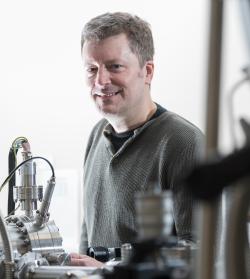Vous êtes ici :
Publié le 16 novembre 2022– Mis à jour le 30 avril 2023
Gavin BELL

Université de Warwick, Royaume-Uni
Professeur invité du laboratoire LPMS
Séjour du 30 novembre au 10 décembre 2022
Curriculum Vitae
Molecular beam epitaxy for quantum materials
Enormous progress is made in developing new quantum materials by growing bulk crystals, cleaving them in vacuum and performing a range of photoemission measurements. However, many spintronic and quantum materials must be in thin film form for practical applications. Furthermore, their properties as ultra-thin films may be very different from the bulk due to quantum confinement or interaction between “top” and “bottom” surface states. Of particular interest are topologically non-trivial states localised at the surfaces and interfaces of certain materials. Molecular beam epitaxy (MBE) is a flexible method for growing thin film materials and, as an ultra-high vacuum method, can be combined with surface-sensitive analytical methods. We are investigating quantum materials such as InBi and SrMnSb2 grown by MBE, using advanced analytical methods to study the electronic band structure, namely angle-resolved photoemission spectroscopy (ARPES). These materials are challenging to grow by MBE and can be highly sensitive to atmospheric contamination, so extra care must be taken to thoroughly characterise the thin films and protect them from degradation before analysis by ARPES. They are grown on standard semiconductor substrates in order to maximise their future potential in next-generation quantum devices.
Projet de recherche
Professeur invité du laboratoire LPMS
Séjour du 30 novembre au 10 décembre 2022
Curriculum Vitae
Molecular beam epitaxy for quantum materials
Enormous progress is made in developing new quantum materials by growing bulk crystals, cleaving them in vacuum and performing a range of photoemission measurements. However, many spintronic and quantum materials must be in thin film form for practical applications. Furthermore, their properties as ultra-thin films may be very different from the bulk due to quantum confinement or interaction between “top” and “bottom” surface states. Of particular interest are topologically non-trivial states localised at the surfaces and interfaces of certain materials. Molecular beam epitaxy (MBE) is a flexible method for growing thin film materials and, as an ultra-high vacuum method, can be combined with surface-sensitive analytical methods. We are investigating quantum materials such as InBi and SrMnSb2 grown by MBE, using advanced analytical methods to study the electronic band structure, namely angle-resolved photoemission spectroscopy (ARPES). These materials are challenging to grow by MBE and can be highly sensitive to atmospheric contamination, so extra care must be taken to thoroughly characterise the thin films and protect them from degradation before analysis by ARPES. They are grown on standard semiconductor substrates in order to maximise their future potential in next-generation quantum devices.
Projet de recherche


